Related Research Articles
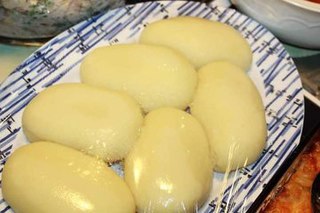
Fufu is a pounded meal or swallow found in West African cuisine. It is a Twi word that originates from the Akans in Ghana. The word, however, has been expanded to include several variations of the pounded meal found in other African countries including Sierra Leone, Guinea, Liberia, Cote D'Ivoire, Benin, Togo, Nigeria, Cameroon, the Democratic Republic of Congo, the Central African Republic, the Republic of Congo, Angola and Gabon.

Ẹ̀bà / Utara as it's commonly known or Pinon is a staple swallow from Nigeria, also eaten in the West African sub-region and other African countries. The term èbà originates from the Yoruba people of southwest Nigeria. It is also called Utara by the Igbo People of Southeast Nigeria. It is a cooked starchy vegetable food made from dried grated cassava (manioc) flour commonly known as garri. It is often eaten with rich soups and stews, with beef, stockfish or mutton. The dish is often described as having a slightly sour, sharp taste.

Ugali or posho or sima is a type of maize swallow made from maize or corn flour in several countries in Africa. Sima is sometimes made from other flours, such as millet or sorghum flour, and is sometimes mixed with cassava flour. It is cooked in boiling water or milk until it reaches a stiff or firm dough-like consistency. In 2017, the dish was added to the UNESCO Representative List of the Intangible Cultural Heritage of Humanity, one of a few foods in the list.
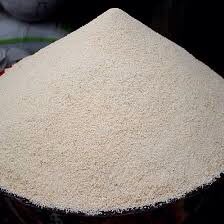
In West Africa, garri is the flour of the fresh starchy cassava root.

Àmàlà is a staple swallow food native to the Yoruba ethnic group of Southwestern Nigeria. It is made of yam, cassava flour, or unripe plantain flour. Tubers of yams are peeled, sliced, cleaned, dried and then ground into flour. It is also called èlùbọ́. Yams are white in colour but turn brown when dried which gives àmàlà its colour. It is a popular side dish served with ewédú and gbẹ̀gìrì, but is also served with a variety of other ọbè(soups), such as ẹ̀fọ́, ilá, and ogbono.

The cuisine of the Democratic Republic of the Congo and the Republic of the Congo varies widely, representing the food of indigenous people. Cassava, fufu, rice, plantain and potatoes are generally the staple foods eaten with other side dishes.

Ghanaian cuisine is the cuisine of the Ghanaian people. Ghanaian main dishes are organized around a starchy staple food, which goes with a sauce or soup containing a protein source. The main ingredients for the vast majority of soups and stews are tomatoes, hot peppers and onions. As a result, most of the Ghanaian soups and stews are red or orange in appearance.

West African cuisine encompasses a diverse range of foods that are split between its 16 countries. In West Africa, many families grow and raise their own food, and within each there is a division of labor. Indigenous foods consist of a number of plant species and animals, and are important to those whose lifestyle depends on farming and hunting.

Nigerian cuisine consists of dishes or food items from the hundreds of ethnic groups that comprise Nigeria. Like other West African cuisines, it uses spices and herbs with palm or groundnut oil to create deeply flavored sauces and soups.
Tuwon masara is a corn flour swallow eaten in the northern part of Nigeria.
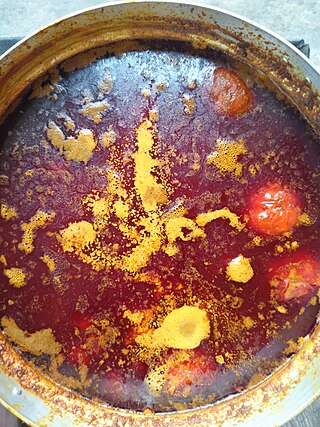
Banga Soup or Palm nut soup is a soup made from palm fruit and it is common in the Ghanaian, Nigerian and Ivorian community. The soup is made from a palm cream or palm nut base. The palm cream is combined with flavorful, marinated meats, smoked dried fish, and aromatics to create a rich, deeply flavored soup that can be eaten with Starch, Fufu, omotuo, banku, fonio, or rice. Palm oil is very significant to Nigerian, Ghanaian and other West African cuisine. This palm nut soup is called by various names in the geographical area.
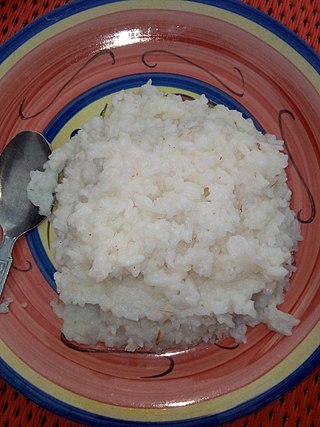
Tuwon shinkafa is a type of Nigerian and Nigerien rice swallow from Niger and the northern part of Nigeria. It is a thick pudding prepared from a local rice that is soft and sticky, and is usually served with different types of soups like miyar kuka, miyar kubewa, and miyar taushe. Two variants made from maize and sorghum flour are called tuwon masara and tuwon dawa, respectively. In Ghana, tuwon shinkafa is called omo tuo.

Miyar kuka or miyan kuka, also known as luru soup, is a type of soup popular among West Africa’s Sahelian ethnic groups. The soup is made from powdered baobab leaves. It is usually served with tuwo or fufu. A seasonal variant of this soup is made using fresh mashed baobab leaves. This variant is only available during the rainy season when fresh baobab leaves are available.
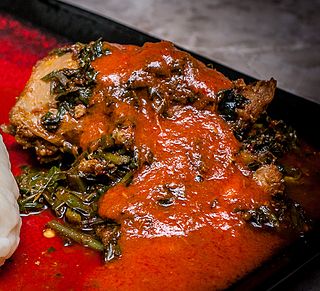
Efo riro is a vegetable soup and a native soup of the Yoruba people of western Nigeria. The two vegetables most commonly used to prepare the soup are Celosia argentea and Amaranthus hybridus.
Hausa cuisines are traditional and modern food prepared by Hausa people. It is based on the availability of raw food materials they can farm or provide from other places. Most times Hausa people depend purely on the farm products they have cultivated for food preparations. Hausa people have a meal that is common to most Zongo communities called Tuo Zaafi.
Eka soup also known as ekuku is a delicacy of three tribes in the Eastern region of Nigeria, it is prepared from mashed palm kernel, roasted groundnut and benne seeds. Eka soup is best taken with starchy foods such as fufu.
Miyar zogale is an hausa dish also known as morninga soup. It is made with moringa leaf as the main ingredient, others include groundnut paste, grounded tomato,beef, cubes, daddawa and palm oil.
Gurasa is a local bread originating from the Northern part of Nigeria, specifically Kano state. It is similar to bread except the dough is lighter. This local Northern bread is eaten for breakfast, lunch, or as a snack.
Potato fufu is a staple swallow food taken by the northern region of Nigeria. It is popular among the Yoruba tribe living in Kwara state. The swallow food is easy to make compared to pounded yam and its unique taste is why the food is prepared at weddings, parties and other occasions.
Edo traditional food consists of dishes or food items common among the people of Edo State. The State is home to various ethnic groups including the Binis, Ishan (Esan), Afemai, Etsako and others. The Traditional food found among these people usually involves soup and swallow. 'swallow' is a term for Nigerian meals that are taken with soup and ingested without chewing.
References
- ↑ "WHAT SOUP? WHERE FROM?". Tribune Online. 2020-09-05. Archived from the original on 2021-11-15. Retrieved 2022-06-17.
- ↑ Dobby (2021-02-16). "Miyan Taushe (Pumpkin Soup)". Dobby's Signature. Archived from the original on 2021-05-08. Retrieved 2022-06-17.
- 1 2 Lois (2017-11-06). "Miyan Taushe: Nigerian Pumpkin Stew/Soup". Yummy Medley. Retrieved 2023-02-24.